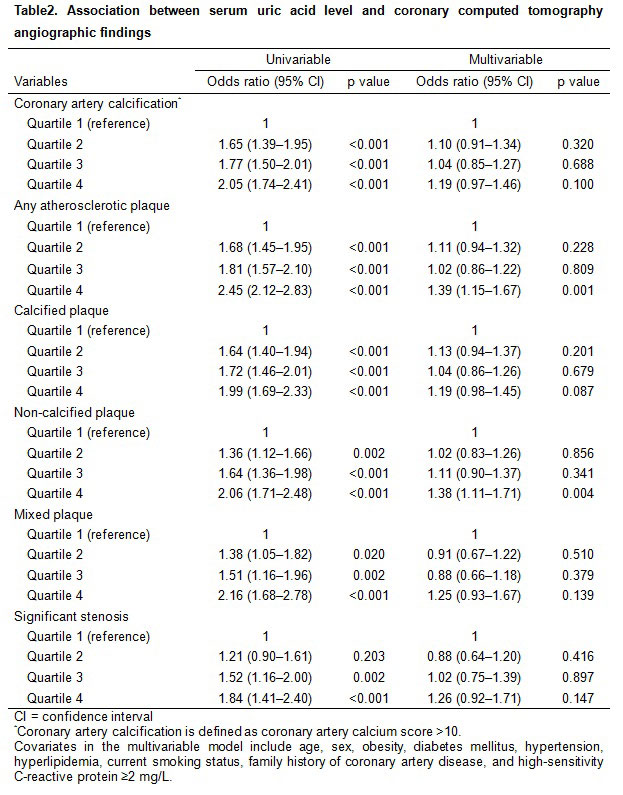Session Information
Session Type: Poster Session (Sunday)
Session Time: 9:00AM-11:00AM
Background/Purpose: High serum uric acid (SUA) level is the main prerequisite for gout, and it might be associated with obesity, hypertension, glucose intolerance, insulin resistance, and dyslipidemia which are the known risk factors for coronary artery disease. Although the association of SUA level with coronary artery disease has been investigated in previous studies, the results are conflicting. Further, there are limited data regarding the association between SUA and subclinical coronary atherosclerosis in asymptomatic individuals. This study investigated the influence of SUA level on subclinical coronary atherosclerosis, as detected by coronary computed tomography angiography (CCTA), in an asymptomatic population.
Methods: We evaluated 6,431 asymptomatic individuals with no prior history of coronary artery disease who voluntarily underwent laboratory tests and CCTA as part of a general health examination. The participants were stratified into quartiles according to their SUA levels (Figure). Coronary atherosclerotic plaques (calcified, mixed, and non-calcified plaques) were assessed using CCTA. Logistic regression analysis was used to determine the association between SUA levels and subclinical coronary atherosclerosis.
Results: Among the 6,431 individuals (mean age, 53.6 ± 7.6 years) in the study, 72.9% were male. The prevalence of any atherosclerotic, calcified, mixed, and non-calcified plaques increased with SUA quartiles (all p < 0.001) (Table 1). After adjustment for cardiovascular risk factors including age, sex, obesity, diabetes mellitus, hypertension, hyperlipidemia, current smoking status, family history of coronary artery disease, and high-sensitivity C-reactive protein ≥2 mg/L., there were no statistically significant differences in the adjusted odds ratios for calcified plaques (1.19; 95% confidence interval [CI] 0.98–1.45; p = 0.087) and mixed plaques (1.25; 95% CI 0.93–1.67; p = 0.139) in the fourth SUA quartile compared to the first quartile. However, the adjusted odds ratios for any atherosclerotic plaque (1.39; 95% CI 1.15–1.67; p = 0.001) and non-calcified plaque (1.38; 95% CI 1.11–1.71; p = 0.004) were significantly higher in the fourth SUA quartile (Table 2).
Conclusion: In asymptomatic individuals, high SUA level was an independent predictor of non-calcified plaques, suggesting an increased cardiovascular risk.
To cite this abstract in AMA style:
Lim D, Park G, Choi S, Choi S, Nam S, Hong S, Kim Y, Lee C, Yoo B. Serum Uric Acid Level and Subclinical Coronary Atherosclerosis in Asymptomatic Individuals: An Observational Cohort Study [abstract]. Arthritis Rheumatol. 2019; 71 (suppl 10). https://acrabstracts.org/abstract/serum-uric-acid-level-and-subclinical-coronary-atherosclerosis-in-asymptomatic-individuals-an-observational-cohort-study/. Accessed .« Back to 2019 ACR/ARP Annual Meeting
ACR Meeting Abstracts - https://acrabstracts.org/abstract/serum-uric-acid-level-and-subclinical-coronary-atherosclerosis-in-asymptomatic-individuals-an-observational-cohort-study/



